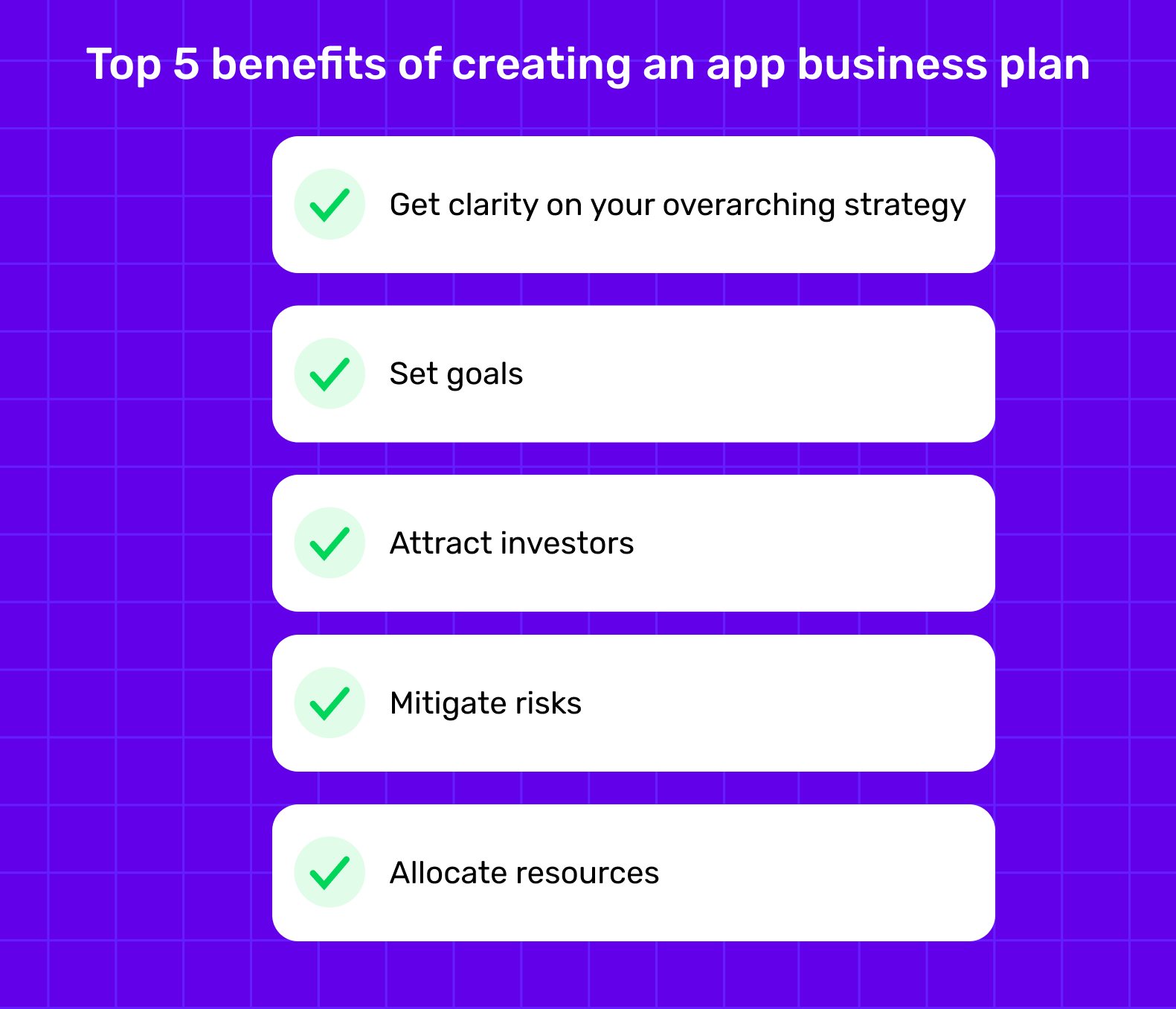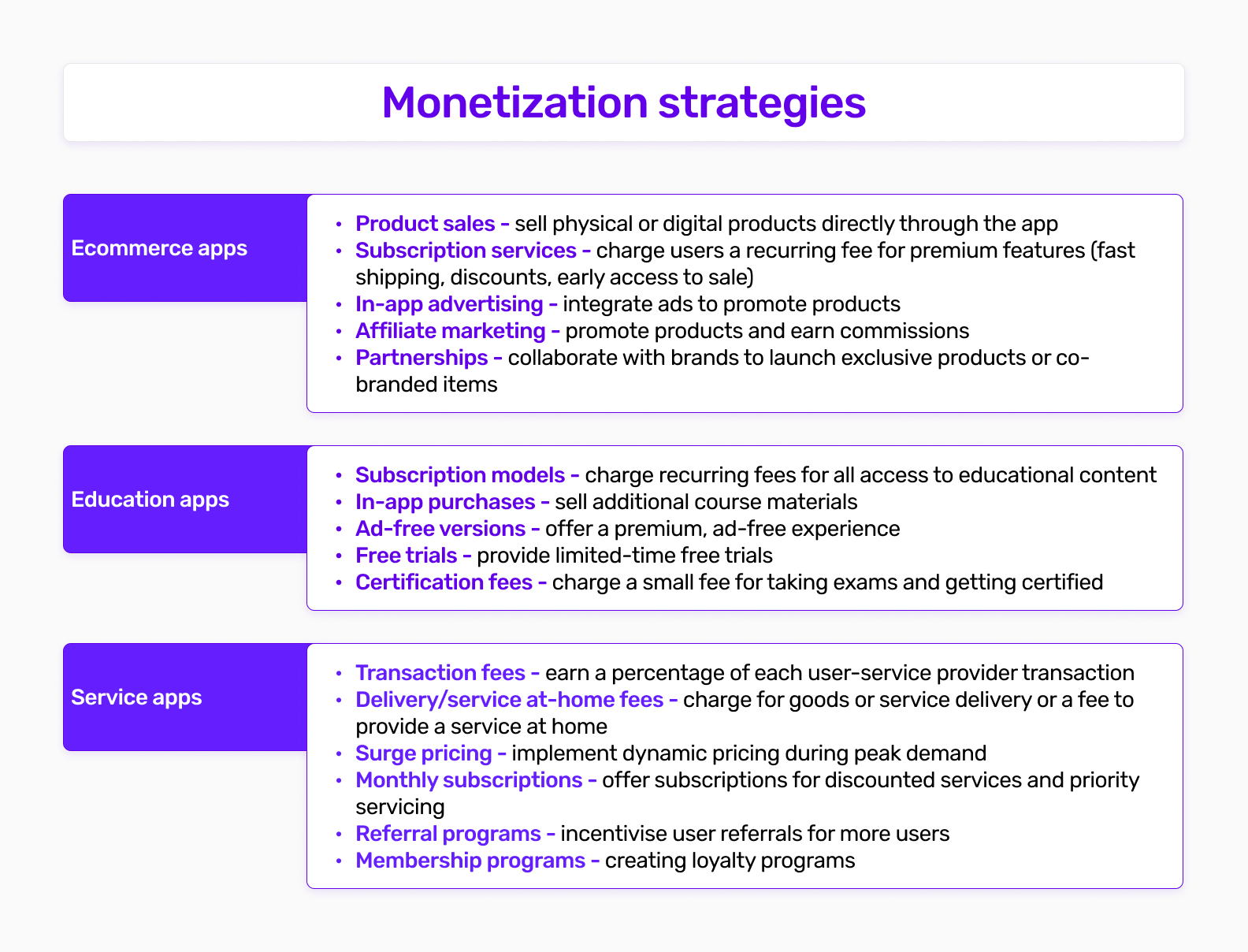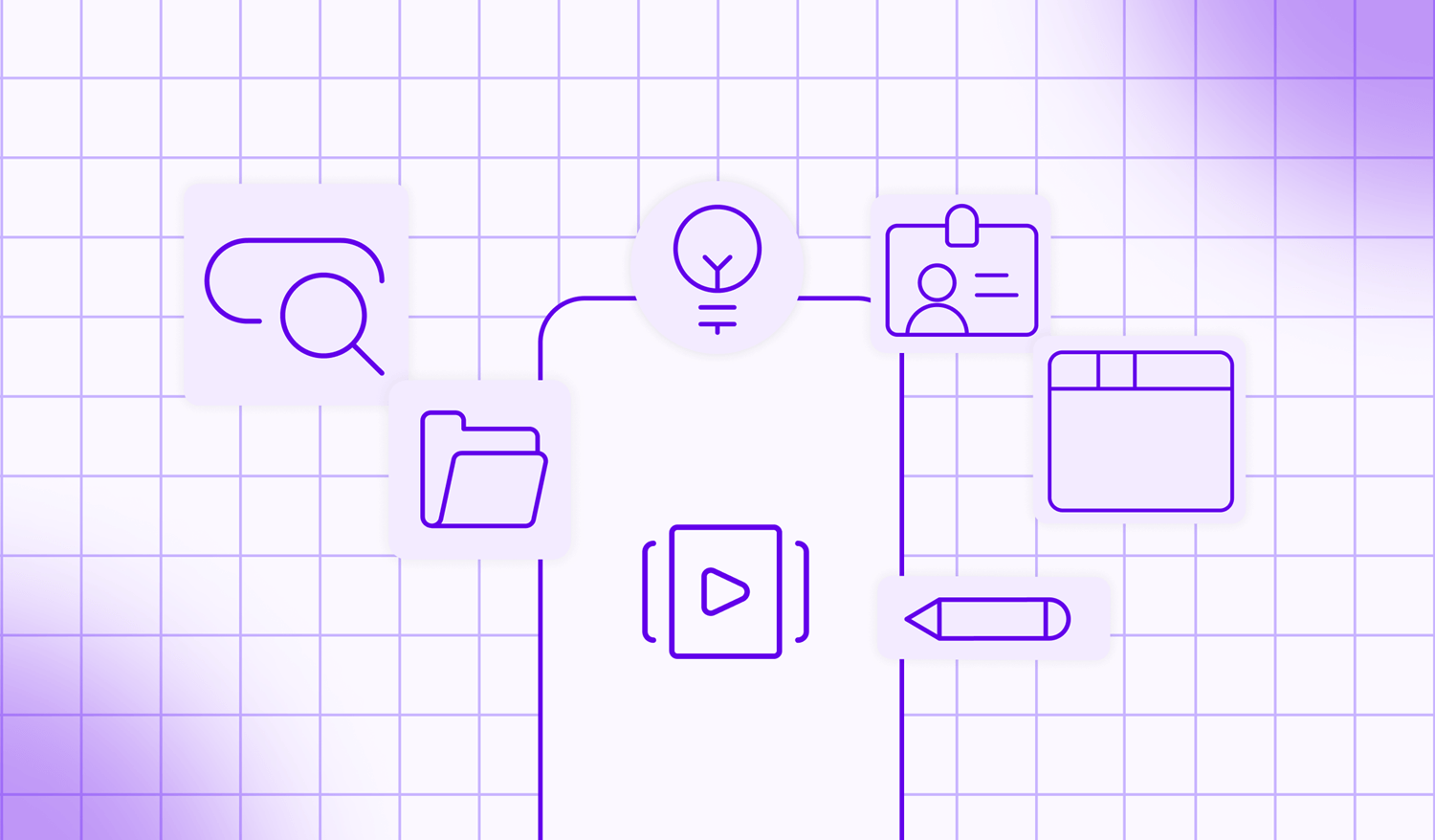Whether it’s understanding an app’s unique benefits, coming up with a killer idea or analysing the costs involved in your project, there are a million-and-one things to do before you actually build an app.
But none of them are quite as important as what I’m going to mention next…
🥁🥁🥁
Creating your app business plan. And the reasons for that are as follows:
Without an app business plan, your app project will be rudderless, meaning it’s unlikely to deliver any tangible results. And without the ability to deliver tangible results, you’ll struggle to get investment from anyone aside from your mum and grandma – if you’re lucky.
But fear not.
In this blog, we’re going to give you a step-by-step guide to creating an app business plan that gets investors salivating. We’ll also give you an idea of what needs to happen once you secure funding and how you can update your plan to capitalise on new opportunities.
Let’s get into it 👇
Why do you need to create an app business plan?
Before we dive into the nitty-gritty of creating an app business plan, let's clarify why it's crucial. A well-constructed app business plan helps you realise the following benefits:
Top 5 benefits of creating an app business plan

- Get clarity on your overarching strategy- articulate your vision and mission, while deciding a clear direction of travel for your app
- Set goals- monitoring app metrics allows you to track your progress and stay focused
- Mitigate risks- by conducting thorough market research and risk analysis, your plan you can identify and address potential pitfalls
- Allocate resources- effectively budget to ensure your app doesn't run out of steam before reaching the finish line
- Attract investors- if you're seeking funding, a well-crafted business plan can be a powerful tool for convincing investors to support your app
Now, let's journey into creating your comprehensive app business plan!👇
7 smooth steps to creating a killer app business plan
1 - Create an executive summary
The executive summary is your business plan's prologue. It introduces readers to your vision, mission, objectives and key metrics, igniting their curiosity and anticipation.
Vision and mission
Your vision is the North Star you want your app business to follow. It's the big picture or the end goal.
Your mission, on the other hand, is your compass, directing your daily efforts towards achieving that vision.
For instance, if you’re creating an ecommerce app, your vision could be to create a dynamic online retail empire that revolutionises the shopping experience.
Your mission could be to provide a wide range of high-quality products and services, delivered with exceptional customer care, making online shopping a seamless and enjoyable journey for our customers.
Business objectives
Goals are the milestones on your journey to success. Make them specific, measurable, achievable, relevant and time-bound (SMART).
For instance, you might aim to generate $100,000 in annual revenue in the first 12 months of your app business. You could use the SMART framework to achieve this goal like so:
- S- I need to register 20,000 users in my first year of business to hit my goal
- M- I need track performance metrics like cost per acquisition, average order value (AOV) and customer lifetime value (CLV) to ensure we’re trending in the right direction
- A- I have a deep understanding of the customer base I’m serving and the problems I need to solve for them, meaning my goal is attainable
- R- I need to scale my user base if I want my business to be sustainable
- T- I can split user acquisition into quarters to monitor my progress
Key metrics
These are the measurable data points that will indicate your app's performance.
Some examples include Customer Acquisition Cost (CAC), churn rate and user satisfaction scores, as well as those mentioned in the section above.
These metrics will be your compass throughout the journey, guiding your decisions and strategies.
For an ecommerce app, you'd want to monitor:
- CAC- aim for $20 or less
- CLV- maintain an average of $100 or more
- Monthly revenue growth- target a 20% month-over-month growth rate
- Churn rate- keep churn below 5% per month
2 - Conduct market research
A house's foundation relies on an understanding of the terrain and climate. Similarly, your app's success hinges on thorough market research.
In this section of your business plan, we'll explore the critical factors for a solid app foundation.
Industry overview
An industry overview provides you with a comprehensive picture of the industry your app will operate. In this phase, you need to discuss market trends, growth potential and any significant players in the field.
For instance, if your app wants to operate in the ecommerce industry, then you should know that, according to Statista, the ecommerce market worldwide is projected to grow by 11.17% (2023-2027), resulting in a market volume of US$5.56tn in 2027.
User pain & gain points
To understand the motivations and pain points of your potential users, ask yourself these questions:
- What problems will your app solve for them?
- What outcomes do you help users achieve?
Your app should cater to the requirements and preferences of your target audience.
3 - Identify your target audience
Your app should align with the needs, preferences and demographics of your target audience. The best way to understand them is by creating detailed buyer personas that reflect your ideal customers.
These personas should provide a deep understanding of your users, including their age, gender, location, interests, behaviours and pain points. The more you understand your various target audiences, the better you can tailor your app to meet their specific needs.
4 - Conduct a competitive analysis
In the vast sea of mobile app stores, your competitors provide you with context, depth, and sometimes friendly rivalry. A thorough competitive analysis is vital and includes understanding the following:
Identifying direct competitors
Identify apps that are similar to yours, offering comparable services or products. Analyse their strengths and weaknesses, their market positioning and their user base. You need to understand the lessons you can learn from their business’ successes and failures.
As an ecommerce app marketplace, for example, an obvious competitor would be Amazon. After performing a competitor SWOT analysis, you might find the following information:
- Strengths- vast product selection, efficient logistics and a strong brand
- Weaknesses - intense competition, limited personalisation
- Opportunities- expanding into new markets and verticals
- Threats- regulatory challenges, reputation management
Identifying indirect competitors
Aside from your direct competitors, alternative solutions may also be competing for your target audience's time and attention.
An ecommerce store, for example, would need to consider bricks-and-mortar stores as part of their competitive analysis. After researching them, you might find the following information:
- Strengths- in-person experience, instant gratification
- Weaknesses- limited product selection, restricted operating hours
- Opportunities- ecommerce integration, enhanced customer service
- Threats- ecommerce competition, evolving consumer behaviour
Uncovering competitive advantages
With this information, you can determine what sets your app apart. It could be a unique feature, a better pricing strategy or a niche focus on a specific user segment. Only by understanding your competitive advantage can you gain clarity about your app's unique value proposition.
Building on who your competitors might be, for an ecommerce offering, you could consider these as your competitive advantages:
- Curated product selection
- Personalised shopping experience
- Superior customer support
- Streamlined mobile shopping
- A loyalty rewards program
Learn how to conduct an app competitive analysis 👈
5 - Nail your numbers
The clarity of your financial data, including your costs, budgets and revenue projections, is a dealbreaker when it comes to securing investor funding. And while you may need to amend them over time, presenting a clear picture is crucial. Here’s how you can start to do that:
App development costs
Estimate the cost of labour, technology, software licences, equipment and other resources. Be detailed in your estimates to avoid unexpected financial surprises. For an in-depth guide, check out our full breakdown of app development costs 👈
Operating expenses
Forecast your ongoing expenses, such as server hosting, marketing, customer support, maintenance and any other operational costs. A well-prepared budget will help you manage your resources effectively.
Revenue projections
Predict your revenue based on user growth and your chosen app monetization strategy. Don’t be too outlandish with your estimates and consider multiple scenarios, including best-case and worst-case, to understand the range of potential outcomes.
Break-even analysis
Determine when your app will start generating enough revenue to cover all its costs. The break-even point is a crucial milestone that indicates the financial sustainability of your app.
6 - Choose your monetization strategy
Knowing how you’ll make money from your app is imperative when creating a business plan. After all, your app needs a revenue strategy to sustain itself! Use the following monetization models (or a combination of these) as inspiration for your own:

7 - Use your business plan to secure app funding
Once you have your business plan, it’s time to use it as a tool to get you the funds you need to develop your app.
Choosing the right funding source depends on your app's stage, funding needs, and the trade-offs you're willing to make in terms of control and equity.
Here are the various avenues you can follow to raise capital for your app business:
Personal savings
If you have personal savings, this can be an initial source of funding for your app business. Using your own funds can give you more control and flexibility.
Bootstrapping
This involves building and growing your app business without external funding. Bootstrapping may require you to invest your own money, work with a small team, and focus on organic growth.
Angel investors
Angel investors are individuals who provide capital to early-stage startups in exchange for equity in the company. Finding the right angel investor can bring not only funding but also valuable expertise and connections.
Venture capital
Venture capital firms invest in startups with high growth potential. They typically provide larger amounts of funding in exchange for equity. Venture capital can fuel rapid expansion, but it also involves giving up a portion of ownership.
Crowdfunding
Crowdfunding platforms, such as Kickstarter or Indiegogo, allow you to raise funds from a large number of people who believe in your app idea. In return, backers may receive rewards or early access to your app.
Bank loans
Traditional bank loans can provide capital for your app business, but they require repayment with interest. Ensure you have a solid business plan and financial projections to secure a loan.
Grants and competitions
Some governments, organisations, and startup competitions offer grants or prizes for innovative app ideas. These opportunities can provide non-dilutive funding.
Pro tip
Creating an app prototype before you pitch to investors is a cost-effective way of visualising your app idea and bringing your pitch deck to life. Check out our app funding 👈 guide for more!
3 steps to follow once your business plan is complete
1 - Create your app
Now that you’ve used your app business plan to secure funding, it’s time to actually create your app. Here are the key steps you need to follow:
Find the right app development team
Depending on your app's complexity, you might need developers, designers, quality assurance experts, project managers and more. Choose individuals or teams with the skills and expertise to execute your vision.
Choose the platform
Select the right app platforms (e.g., iOS, Android, web) and technologies that align with your app's objectives. Different platforms offer different advantages and cater to distinct user bases, so choose wisely. Additionally, consider the technology stack and tools required for development.
Select features and functionalities
Define the core features of your app. For instance, if you're building an ecommerce app, you might need:
- Secure payment processing
- User-friendly product search and filters
- Product recommendations
- Customer reviews and ratings
- Wish lists and shopping carts
- Order tracking and customer support
- User profiles and loyalty program integration
Set development timeline
Set milestones and deadlines for your app's development phases. A well-structured timeline helps you track progress, manage resources and launch your app on schedule. Be realistic and account for unexpected delays that can occur during development.
2 - Market and promote your app
With your ship constructed and your crew assembled, it's time to set sail. But even the most magnificent vessel needs wind in its sails and a map to follow.
Using the following app marketing strategies, your shoppers will know where to find you and what you offer!
App store optimization (ASO)
ASO is the practice of optimising your app's metadata—such as title, keywords, and description—to improve its discoverability in app stores. Employ keywords strategically, use high-quality visuals, and encourage positive reviews.
Social media marketing
Leverage social media platforms to connect with your audience, promote your app, and interact with users. Platforms like Facebook, Instagram, X and LinkedIn are popular for app marketing. You can partner with influencers or industry experts who can promote your app to their followers, providing authenticity and expanding your reach.
Email marketing
Build an email list to communicate with your audience. Send newsletters, updates, display app features, performance and special offers to keep users engaged and informed.
Search engine optimization (SEO)
Optimise your website and content for search engines to improve organic discoverability, particularly if you have a website supporting your app.
Paid advertising
Invest in various paid advertising channels, such as:
- Google Ads- run ads on Google Search, Display Network, YouTube and Google Play Store
- Facebook, Instagram and LinkedIn Ads- use various social media platforms for targeted advertising
- X and Threads Ads- promote your app through sponsored posts
- Apple Search Ads- advertise on the Apple App Store
- Programmatic Advertising- use automated ad buying to reach the right audience across multiple platforms
Events and trade show marketing
Participate in industry specific events, trade shows and conferences to network, showcase your app and gain recognition.
Location marketing
For location-based apps, use local marketing tactics such as geo targeted ads, promotions, and partnerships with local businesses.
3 - Perform an internal app SWOT analysis
To ensure the long-term success of your app, you need to update your business plans as well as your app’s features and functionalities.
To do this, you can use a SWOT analysis. SWOT analysis is a simple yet powerful strategic planning tool that helps you evaluate your app’s Strengths, Weaknesses, Opportunities and Threats.
This analysis helps you gain a better understanding of your app's current position in the market and make informed decisions about its future development and marketing strategies.
It also helps you identify your competitive advantage to stand out and attract more users, which may change over time, depending on the conditions of the market.
Strengths
The first step towards conducting a SWOT analysis for your app is to identify its current strengths. This involves taking an honest and comprehensive look at what your app excels at in its current state.
Weaknesses
After identifying your app’s strengths, it’s time to acknowledge its weaknesses. This involves pinpointing areas where your app needs improvement to enhance the overall user experience, usability and value propositions.
Opportunities
Opportunities refer to the external factors and circumstances that you can leverage to your app’s advantage. This section focuses on recent trends and favourable conditions so your app can gain a competitive edge and expand its user base.
Threats
Threats have a tendency to lurk in the corner and haunt. Don’t fear them, get them in the front and tackle them individually. Threats can stem from external risks like market risks, financial risks, legal and compliance risks that we need to account for and vary.
Conclusion
By now, you have all the information you need to create a killer app business plan and a good idea of how you can use it to secure funding.
It’s important to remember though, that you can’t just set and forget the work you do in this exercise. Instead, you need to continually evolve your plans to meet emerging customer needs and to capitalise on any opportunities the market presents.
Subscribe to our newsletter for more ecommerce inspiration👇
Want to start your app project with us?
Book a demoSpeak with one of our product experts today.
By proceeding you agree to Builder.ai’s privacy policy and terms and conditions

Ridhima is the Global Head of Marketing at Builder.ai. With 16+ years of experience in delivering data-driven, strategic marketing campaigns, Ridhima’s innovative approach has accelerated growth within the marketing and content teams.













 Facebook
Facebook X
X LinkedIn
LinkedIn YouTube
YouTube Instagram
Instagram RSS
RSS


